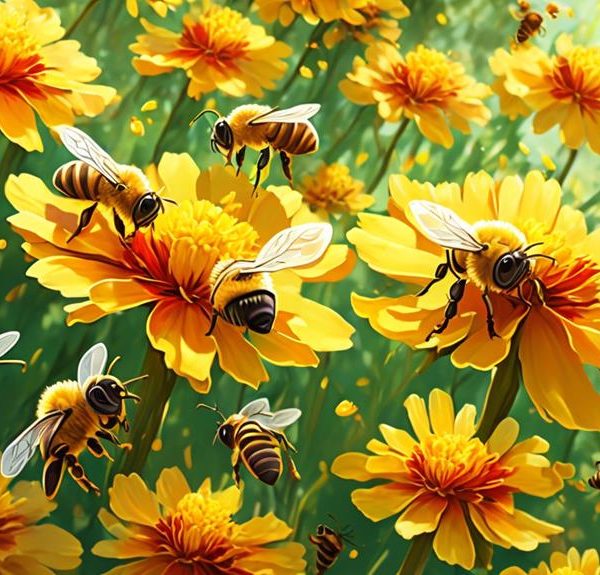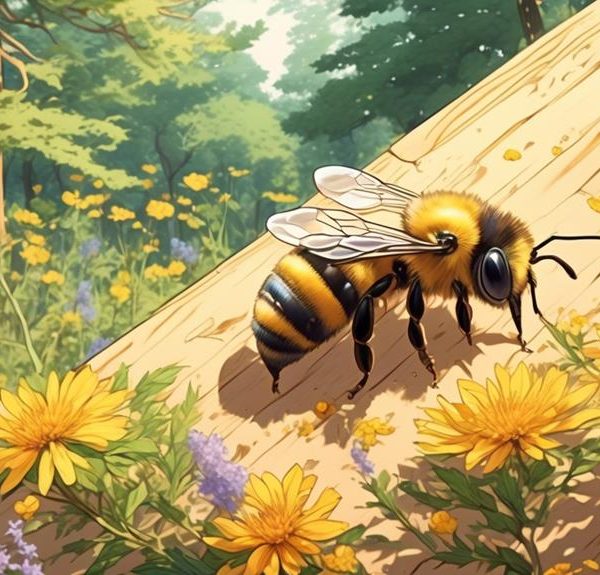Witness the fascinating, symbiotic relationship between bees and goldenrod, integral to their survival, and discover what draws them together.
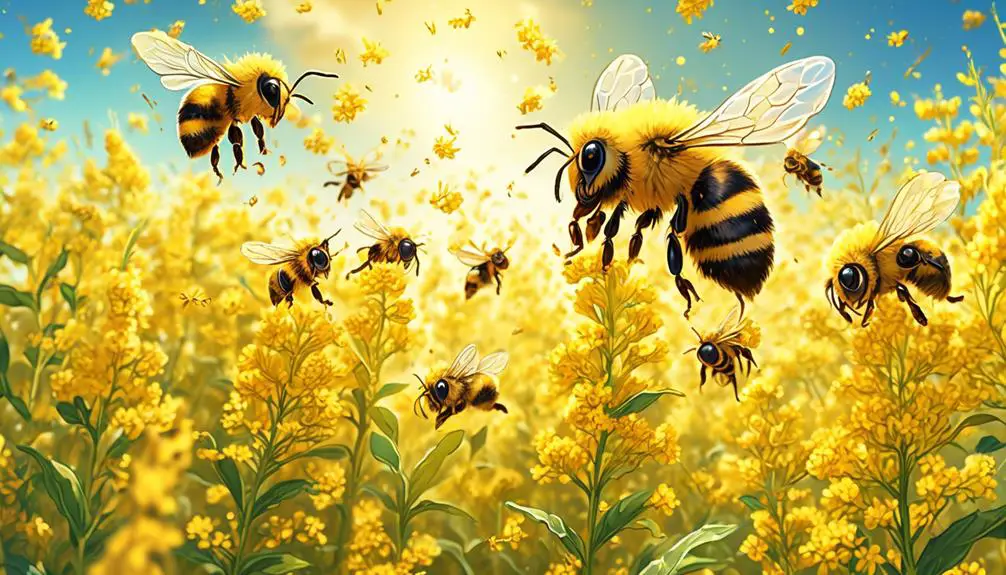
Do Bees Like Goldenrod?
Imagine you're a beekeeper in the horse-and-buggy days, observing your buzz-worthy charges as they flit from flower to flower. One flower in particular seems to attract them more than others – the goldenrod. You've probably wondered, just as many modern bee enthusiasts do, if bees truly have an affinity for this vibrant, yellow plant.
The relationship between bees and goldenrod is, indeed, a fascinating subject. There's more to it than meets the eye, and the implications for both bee and plant survival are substantial. Let's uncover this intriguing symbiotic relationship together.
Key Takeaways
- Bees rely on goldenrod as a valuable food source due to its abundant nectar and protein-rich pollen.
- Goldenrod plays a crucial role in bee survival, especially during late summer and approaching winter.
- Bees unintentionally contribute to goldenrod plant fertilization while collecting pollen.
- The bond between bees and goldenrod is significant for honey production, biodiversity conservation, and shaping bee conservation efforts.
Understanding the Bee's Diet
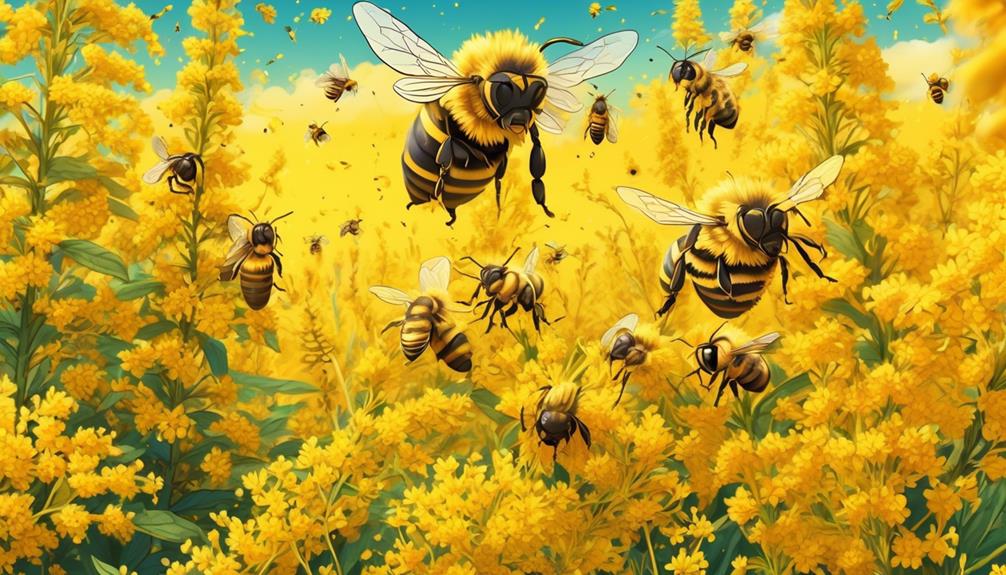
While you might think bees only indulge in nectar from flowers, in reality, their diet is far more diverse and fascinating. You see, bees aren't just nectar-guzzlers; they're also pollen collectors. Pollen, a powdery substance produced by the male part of flowers, serves as a protein source for bees. It's essential for their growth and development, particularly for young bees.
Furthermore, bees need water, which they use not only for hydration but also for cooling their hives and diluting honey. It's also interesting to note that bees feed on honeydew, a sweet liquid excreted by aphids. This offers them an alternative source of nutrients when nectar is scarce.
Therefore, bees' food preferences can vary depending on the availability and the nutritional content of the food sources around them. For instance, goldenrod, a plant commonly found in North America, is a favorite among bees due to its high nectar and pollen content.
The Significance of Goldenrod
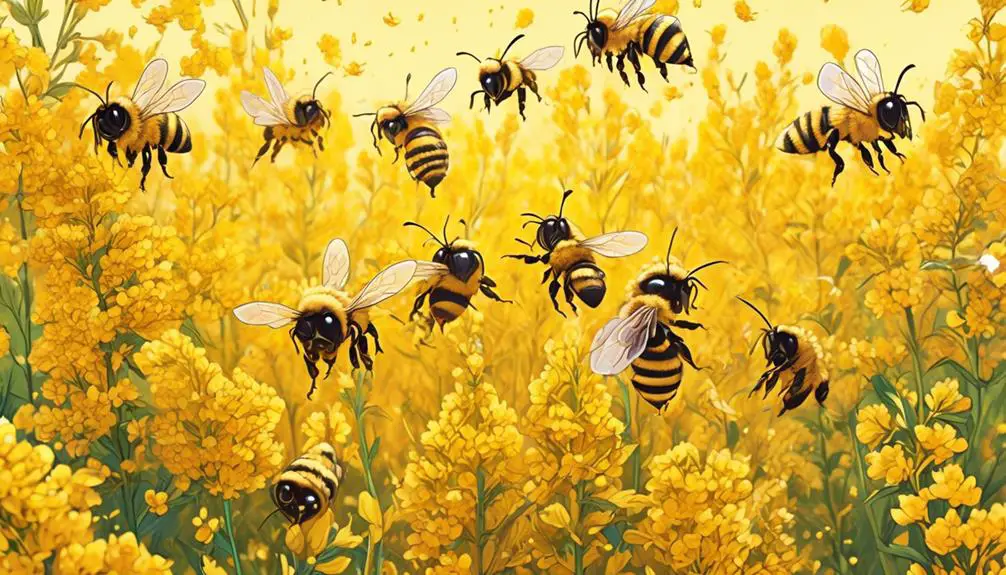
You might be wondering, what's so special about goldenrod that it stands out in the diverse diet of bees? Well, goldenrod is a late-summer bloomer, providing an abundant source of nectar and pollen when most other flowers have finished their cycle. It's a lifeline for bees, allowing them to stock up on much-needed resources for the winter.
The goldenrod's bright yellow hue and strong scent are irresistible to bees, drawing them in from miles around. This plant's nectar is particularly rich in sugars, offering a high-energy food source for these hardworking insects. Similarly, the pollen is packed with proteins, essential for bee growth and development.
Moreover, goldenrod offers more than just a food source. Its dense clusters of flowers provide shelter and breeding grounds for bees. And, it's not just about the bees; goldenrod plays a crucial role in the broader ecosystem, attracting a range of pollinators and supporting biodiversity.
How Bees Interact With Goldenrod
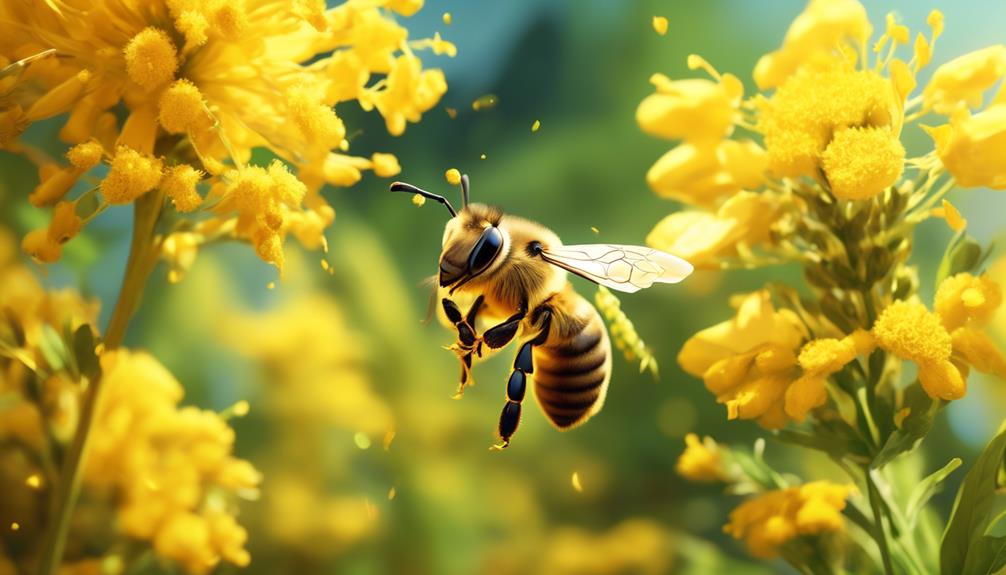
Having established the importance of goldenrod for bees, let's now explore the specific interactions between these industrious insects and this vibrant plant.
Goldenrod is a late-summer bloomer, providing pollen and nectar when other food sources are dwindling. When you observe a field of goldenrod, you'll notice it's alive with bees, busily collecting and transferring pollen. Their legs, covered with specialized hairs, act like pollen brushes, sweeping up the tiny grains. As they move from flower to flower, they inadvertently fertilize the plants, ensuring the next generation of goldenrod.
You might also notice bees sipping nectar from these flowers. They use this sweet liquid to produce honey, their winter food supply. Goldenrod nectar is particularly rich in sugars, making it a valuable resource.
It's worth noting that goldenrod is also a magnet for other insects, which can lead to competition for resources. However, bees are typically efficient foragers, often outcompeting others.
The Role of Goldenrod in Bee Survival
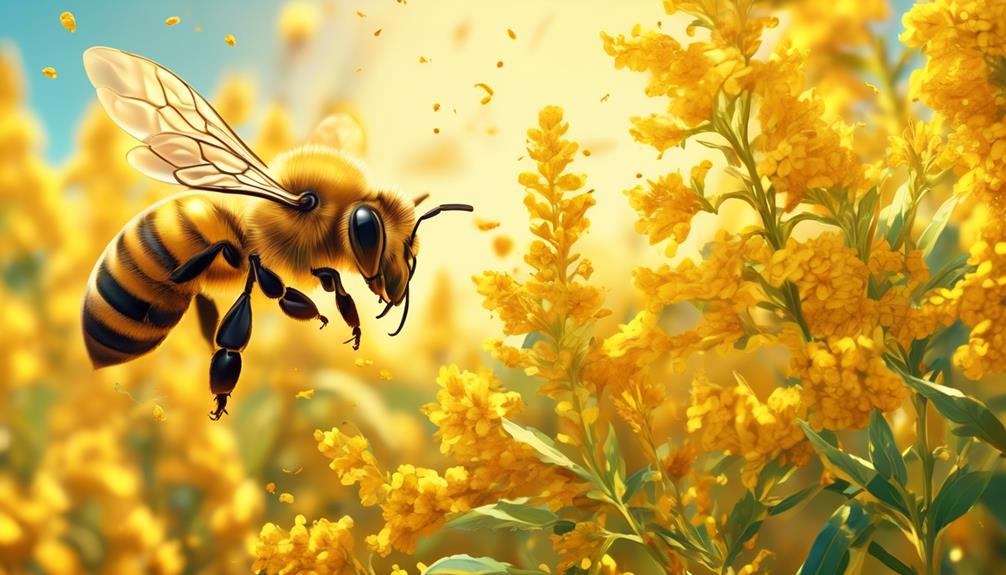
In the cyclical dance of survival, goldenrod plays a pivotal role for bees, especially as winter approaches. As you might know, most flowers cease blooming in the fall, leaving bees with fewer food sources. But goldenrod, with its vibrant yellow blossoms, is a late bloomer. It's a lifeline for bees when other floral nectars are scarce.
You see, bees need to collect enough nectar and pollen to produce honey, which is their winter food supply. Goldenrod's ample nectar and high pollen count make it ideal for this purpose. Moreover, the plant's longevity—blooming until the first frost—gives bees more time to gather what they need.
But goldenrod does more than just feed bees. Its pollen has been found to contain beneficial fungi that can help bees fight off harmful pathogens. So, in a way, goldenrod also plays a role in bee health.
However, it's not just about survival. Goldenrod honey, with its unique flavor profile, is a prized product in the beekeeping industry. Thus, goldenrod's role extends beyond survival, contributing to the thriving of bees and their keepers alike.
Clearly, goldenrod is crucial in the grand scheme of bee survival.
Case Studies: Bees and Goldenrod
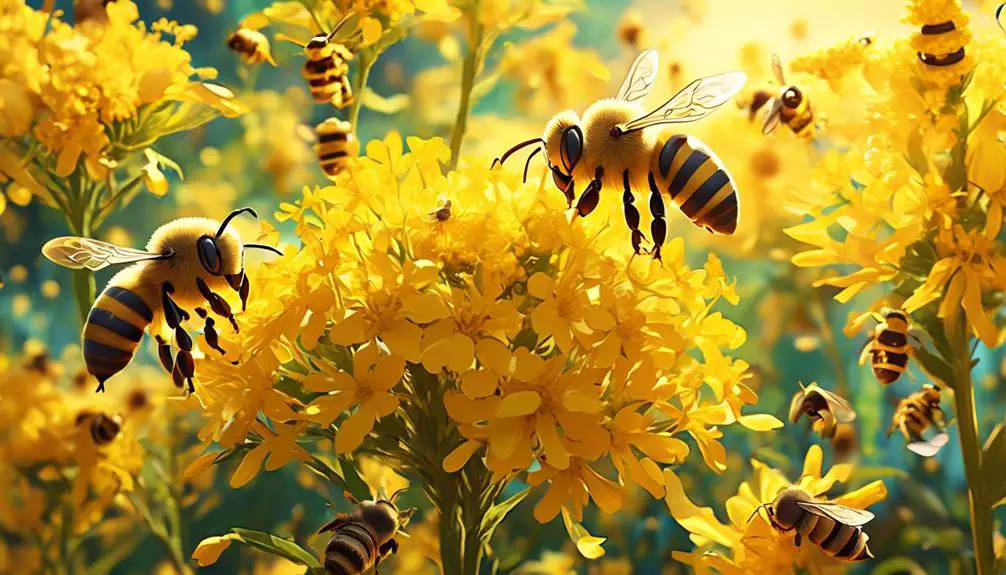
To further illustrate the symbiotic relationship between bees and goldenrod, let's explore several case studies that shed light on this critical connection.
In a study conducted by the University of Minnesota, researchers found that bees prefer goldenrod over other late-season plants. The study indicated that goldenrod's high nectar and pollen production, coupled with its late blooming period, makes it an ideal food source for bees preparing for winter.
Another study from the Xerces Society showed the vital role goldenrod plays in native bee conservation. The study found that many native bee species rely heavily on goldenrod pollen for their survival. This highlights goldenrod's significant contribution to maintaining biodiversity.
Lastly, a case study by the USDA demonstrated goldenrod's influence on honey production. Bees feeding on goldenrod produced honey with a distinctive flavor and color. This not only provides a unique product for honey producers but also further signifies goldenrod's importance to the bee ecosystem.
These studies collectively underscore the crucial bond between bees and goldenrod. They clearly demonstrate how this plant acts as a lifeline for bees, contributing significantly to their survival, honey production, and biodiversity conservation.
Implications for Bee Conservation Efforts
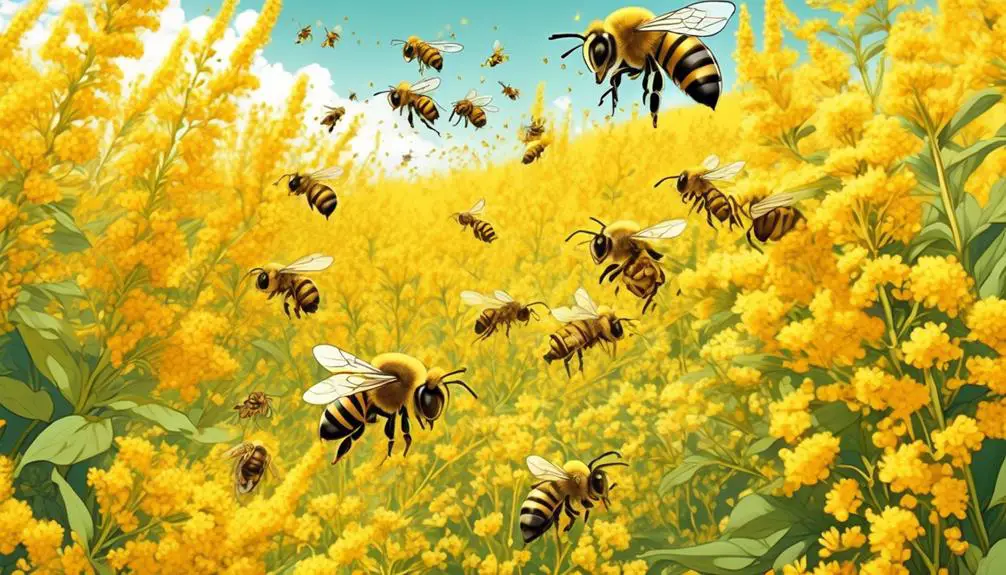
With the alarming decline in bee populations, understanding the crucial role of goldenrod in their survival can significantly shape your conservation efforts. Goldenrod, known for its late blooming, serves as a vital food source for bees, especially as other flowers wilt. This knowledge can guide you in designing landscapes that ensure year-round food availability for bees.
However, it's not just about planting more goldenrod. You need to create a diverse habitat. While goldenrod is indeed beneficial, an overabundance can lead to a lack of plant diversity, which isn't healthy for bees. It's important to balance the presence of goldenrod with other native plants to support a well-rounded diet and habitat for bees.
Lastly, consider the threats to goldenrod. Pesticide use and habitat loss due to urbanization are significant concerns. Advocating for pesticide regulations and habitat preservation can be crucial steps in your conservation strategy.
Frequently Asked Questions
What Other Plants Do Bees Typically Prefer Over Goldenrod?
You're asking about the preferences of bees when it comes to plants, other than goldenrod. Well, bees are quite fond of a variety of plants. They particularly favor lavender, sunflowers, and clover. These plants not only provide ample nectar but also have flower shapes that are easy for bees to access.
Are There Any Known Adverse Effects on Bees From Consuming Goldenrod Nectar?
You're wondering if there are adverse effects on bees from consuming goldenrod nectar. No, there aren't any known harmful impacts.
In fact, goldenrod nectar is rich in nutrients, and it's a vital food source for bees, especially in the late summer and early fall.
However, it's worth noting that a diverse diet is crucial for bee health, so they shouldn't rely solely on goldenrod but also consume nectar from a variety of other plants.
Does the Presence of Goldenrod Affect the Behavior of Bees in Any Noticeable Way?
Yes, the presence of goldenrod significantly influences bee behavior. They're attracted to its bright yellow flowers. It's a vital late-summer food source, providing nectar and pollen when other flowers aren't blooming.
You'll often see bees busily foraging on goldenrod, storing up food for winter. However, it doesn't alter their behavior negatively. Instead, it helps sustain them, proving to be beneficial for their survival.
How Does Goldenrod Compare to Other Plants in Terms of Its Nutritional Value for Bees?
You're wondering about goldenrod's nutritional value for bees compared to other plants. Well, it's pretty high up there!
Bees are really attracted to goldenrod because it's rich in both nectar and pollen. Plus, it blooms late in the season when other food sources are scarce.
So, it's not just a matter of liking, it's vital for a bee's survival.
It's like a big, yellow, nutritious buffet for our buzzing friends!
Can the Proliferation of Goldenrod Be Used as an Indicator of a Healthy Bee Population?
Yes, you can use the proliferation of goldenrod as an indicator of a healthy bee population. Bees are attracted to goldenrod due to its high pollen and nectar content. If you're seeing a lot of goldenrod, it's likely there's a robust bee population nearby to pollinate it.
However, keep in mind it's not a foolproof method, as other factors can also influence goldenrod growth.
Conclusion
So, you've learned that bees do indeed love goldenrod. This plant plays a crucial role in their survival, providing them with necessary nutrients during the fall. Case studies highlight their symbiotic relationship.
As goldenrod's significance becomes clearer, it's evident that conserving these plants could be a game-changer in bee preservation efforts. So, don't overlook goldenrod's importance in our ecosystem.
After all, a world without bees is far less sweet.

